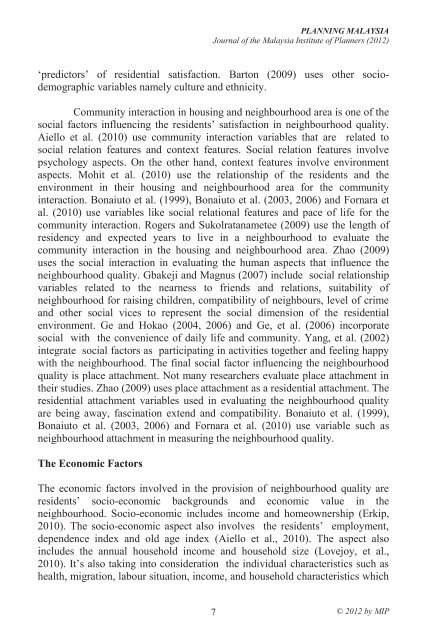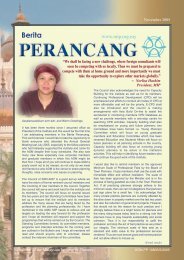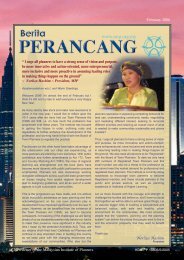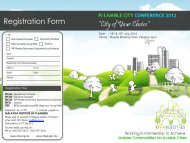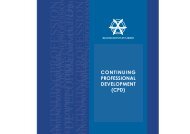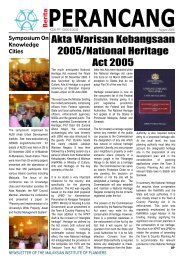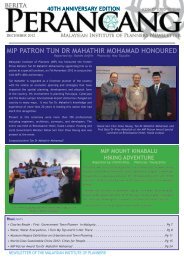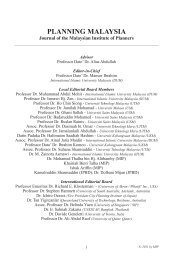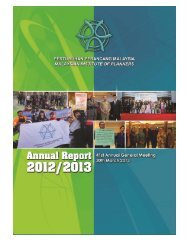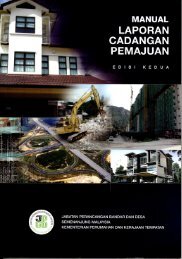Untitled - Malaysian Institute of Planners
Untitled - Malaysian Institute of Planners
Untitled - Malaysian Institute of Planners
Create successful ePaper yourself
Turn your PDF publications into a flip-book with our unique Google optimized e-Paper software.
PLANNING MALAYSIAJournal <strong>of</strong> the Malaysia <strong>Institute</strong> <strong>of</strong> <strong>Planners</strong> (2012)‘predictors’ <strong>of</strong> residential satisfaction. Barton (2009) uses other sociodemographicvariables namely culture and ethnicity.Community interaction in housing and neighbourhood area is one <strong>of</strong> thesocial factors influencing the residents’ satisfaction in neighbourhood quality.Aiello et al. (2010) use community interaction variables that are related tosocial relation features and context features. Social relation features involvepsychology aspects. On the other hand, context features involve environmentaspects. Mohit et al. (2010) use the relationship <strong>of</strong> the residents and theenvironment in their housing and neighbourhood area for the communityinteraction. Bonaiuto et al. (1999), Bonaiuto et al. (2003, 2006) and Fornara etal. (2010) use variables like social relational features and pace <strong>of</strong> life for thecommunity interaction. Rogers and Sukolratanametee (2009) use the length <strong>of</strong>residency and expected years to live in a neighbourhood to evaluate thecommunity interaction in the housing and neighbourhood area. Zhao (2009)uses the social interaction in evaluating the human aspects that influence theneighbourhood quality. Gbakeji and Magnus (2007) include social relationshipvariables related to the nearness to friends and relations, suitability <strong>of</strong>neighbourhood for raising children, compatibility <strong>of</strong> neighbours, level <strong>of</strong> crimeand other social vices to represent the social dimension <strong>of</strong> the residentialenvironment. Ge and Hokao (2004, 2006) and Ge, et al. (2006) incorporatesocial with the convenience <strong>of</strong> daily life and community. Yang, et al. (2002)integrate social factors as participating in activities together and feeling happywith the neighbourhood. The final social factor influencing the neighbourhoodquality is place attachment. Not many researchers evaluate place attachment intheir studies. Zhao (2009) uses place attachment as a residential attachment. Theresidential attachment variables used in evaluating the neighbourhood qualityare being away, fascination extend and compatibility. Bonaiuto et al. (1999),Bonaiuto et al. (2003, 2006) and Fornara et al. (2010) use variable such asneighbourhood attachment in measuring the neighbourhood quality.The economic factors involved in the provision <strong>of</strong> neighbourhood quality areresidents’ socio-economic backgrounds and economic value in theneighbourhood. Socio-economic includes income and homeownership (Erkip,2010). The socio-economic aspect also involves the residents’ employment,dependence index and old age index (Aiello et al., 2010). The aspect alsoincludes the annual household income and household size (Lovejoy, et al.,2010). It’s also taking into consideration the individual characteristics such ashealth, migration, labour situation, income, and household characteristics which7© 2012 by MIP


